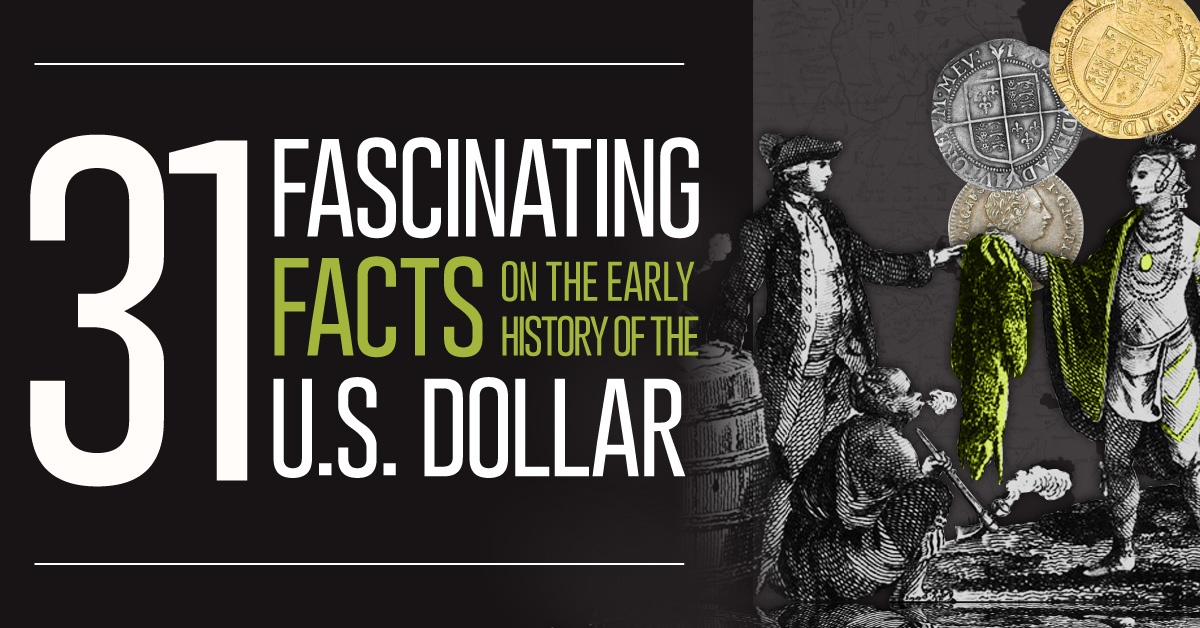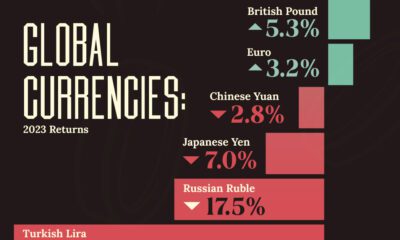Money
31 Fascinating Facts on the Early History of the U.S. Dollar
The Money Project is an ongoing collaboration between Visual Capitalist and Texas Precious Metals that seeks to use intuitive visualizations to explore the origins, nature, and use of money.

Today, we all know the U.S. dollar as an iconic currency that is recognizable to people around the world.
And while we’ve previously looked at the buying power of the U.S. dollar over time, as well as important events like the Great Depression, we have not looked at the history of the dollar itself.
How and why was it conceived, and why do we call it a “dollar” or a “buck”? How did the dollar’s early history help to shape today’s world?
Before the Dollar
For the early colonists, currency was a bit of a free-for-all.
Officially, cash was denominated in pounds, shillings, and pence, but in reality things were a different story. Cash was often scarce, and colonists needed to be innovative to fulfill transactions. At various points in time, they used tobacco, beaver skins, and wampum in the place of money. Some colonies even tried to issue their own fiat currencies – many of which went bust.
As it turned out, the Spanish dollar was often the most abundant form of cash – and this is what led to U.S. currency eventually being denominated in dollars.
The Revolution
During the American Revolution in 1775, the Continental Congress issued a money known as the Continental Currency to try and fund the war. The government printed too many, and the value of a Continental diminished rapidly.
Just five years later, after runaway inflation, the Continental was worth 2.5% of its face value. Benjamin Franklin rightly noted that the depreciation of the Continental had, in fact, acted as a tax to pay for the war. Holders of the currency – everyday people – were punished by losing massive amounts of buying power. Interestingly, this is where we get the phrase “Not worth a Continental”.
Birth of the Dollar
The failure of the Continental Currency must have been top of mind during the writing of the Constitution. A clause was even added, under Article 1, Section 10, to make sure such a failure would never happen again. It was written that states were not permitted to “coin Money; emit Bills of Credit; [or] make any Thing but gold and silver Coin a Tender in Payment of Debts.”
And so, the Coinage Act of 1792 created the U.S. dollar as a standard unit of currency. The U.S. Mint was authorized to oversee coinage, and the Act also established a penalty of death for debasing coinage issued by the Mint.
The Almighty Buck
In the 19th Century, a new slang term emerged for the dollar.
Especially in the Great Lakes area, different amounts of money were equated with animal skins. One particular reference showed that in Ohio in 1851, the skin of a muskrat was worth $0.25, and that of a doe was worth $0.50. Meanwhile, the skin of a buck was equal to the “almighty dollar” – and hence, the word “buck” became synonymous with the U.S. dollar.
The Civil War
Leading up to the Civil War, private banks around the country issued their own paper currencies.
With 10,000 or so of these currencies in circulation as the war broke out, governments soon found it very cumbersome to try and pay debts with many different types of notes. As a result, the $10 Demand Note was the first official paper currency issued in 1861 by the government to help finance the war.
The North began paying debts with a fiat currency called the “greenback”, while Confederate states issued their own paper currency as well. The latter was worthless by the time the Confederacy lost the war.
The Counterfeiting Problem
Around this time, counterfeiting was a widespread problem with greenbacks and all the private notes that were circulating. More than 1/3 of bills were fake at this time.
Sophisticated counterfeit operations were happening in British Canada, and some bank engravers would even moonlight as counterfeiters, using the same plates and dyes they had from their day job.
To deal with the problem, the Secret Service was formed in 1865.
The Modern Dollar
Counterfeiting measures have come a long way since the late 19th century. Today, it’s estimated that less than 0.01% of notes are fake.
Learn more about the modern U.S. dollar in the next part of this series.
The Money Project is an ongoing collaboration between Visual Capitalist and Texas Precious Metals that seeks to use intuitive visualizations to explore the origins, nature, and use of money.
Money
Charted: Which City Has the Most Billionaires in 2024?
Just two countries account for half of the top 20 cities with the most billionaires. And the majority of the other half are found in Asia.

Charted: Which Country Has the Most Billionaires in 2024?
This was originally posted on our Voronoi app. Download the app for free on iOS or Android and discover incredible data-driven charts from a variety of trusted sources.
Some cities seem to attract the rich. Take New York City for example, which has 340,000 high-net-worth residents with investable assets of more than $1 million.
But there’s a vast difference between being a millionaire and a billionaire. So where do the richest of them all live?
Using data from the Hurun Global Rich List 2024, we rank the top 20 cities with the highest number of billionaires in 2024.
A caveat to these rich lists: sources often vary on figures and exact rankings. For example, in last year’s reports, Forbes had New York as the city with the most billionaires, while the Hurun Global Rich List placed Beijing at the top spot.
Ranked: Top 20 Cities with the Most Billionaires in 2024
The Chinese economy’s doldrums over the course of the past year have affected its ultra-wealthy residents in key cities.
Beijing, the city with the most billionaires in 2023, has not only ceded its spot to New York, but has dropped to #4, overtaken by London and Mumbai.
| Rank | City | Billionaires | Rank Change YoY |
|---|---|---|---|
| 1 | 🇺🇸 New York | 119 | +1 |
| 2 | 🇬🇧 London | 97 | +3 |
| 3 | 🇮🇳 Mumbai | 92 | +4 |
| 4 | 🇨🇳 Beijing | 91 | -3 |
| 5 | 🇨🇳 Shanghai | 87 | -2 |
| 6 | 🇨🇳 Shenzhen | 84 | -2 |
| 7 | 🇭🇰 Hong Kong | 65 | -1 |
| 8 | 🇷🇺 Moscow | 59 | No Change |
| 9 | 🇮🇳 New Delhi | 57 | +6 |
| 10 | 🇺🇸 San Francisco | 52 | No Change |
| 11 | 🇹🇭 Bangkok | 49 | +2 |
| 12 | 🇹🇼 Taipei | 45 | +2 |
| 13 | 🇫🇷 Paris | 44 | -2 |
| 14 | 🇨🇳 Hangzhou | 43 | -5 |
| 15 | 🇸🇬 Singapore | 42 | New to Top 20 |
| 16 | 🇨🇳 Guangzhou | 39 | -4 |
| 17T | 🇮🇩 Jakarta | 37 | +1 |
| 17T | 🇧🇷 Sao Paulo | 37 | No Change |
| 19T | 🇺🇸 Los Angeles | 31 | No Change |
| 19T | 🇰🇷 Seoul | 31 | -3 |
In fact all Chinese cities on the top 20 list have lost billionaires between 2023–24. Consequently, they’ve all lost ranking spots as well, with Hangzhou seeing the biggest slide (-5) in the top 20.
Where China lost, all other Asian cities—except Seoul—in the top 20 have gained ranks. Indian cities lead the way, with New Delhi (+6) and Mumbai (+3) having climbed the most.
At a country level, China and the U.S combine to make up half of the cities in the top 20. They are also home to about half of the world’s 3,200 billionaire population.
In other news of note: Hurun officially counts Taylor Swift as a billionaire, estimating her net worth at $1.2 billion.
-

 Education1 week ago
Education1 week agoHow Hard Is It to Get Into an Ivy League School?
-

 Technology2 weeks ago
Technology2 weeks agoRanked: Semiconductor Companies by Industry Revenue Share
-

 Markets2 weeks ago
Markets2 weeks agoRanked: The World’s Top Flight Routes, by Revenue
-

 Demographics2 weeks ago
Demographics2 weeks agoPopulation Projections: The World’s 6 Largest Countries in 2075
-

 Markets2 weeks ago
Markets2 weeks agoThe Top 10 States by Real GDP Growth in 2023
-

 Demographics2 weeks ago
Demographics2 weeks agoThe Smallest Gender Wage Gaps in OECD Countries
-

 Economy2 weeks ago
Economy2 weeks agoWhere U.S. Inflation Hit the Hardest in March 2024
-

 Green2 weeks ago
Green2 weeks agoTop Countries By Forest Growth Since 2001
















